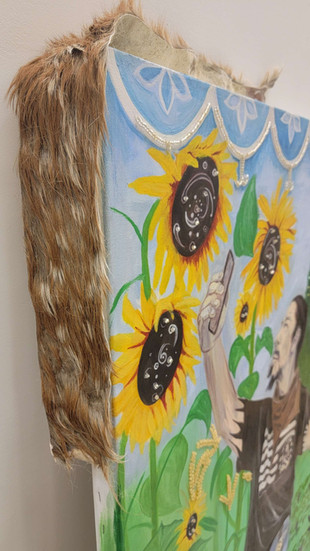Re-indigenization
- Fileve Tlaloc

- Dec 27, 2024
- 6 min read
On November 15th, the full moon brightened the night sky as the FNB gallery in Olean, NY opened its third and final show of 2024. My work was on display with 2 of the other artists in residents. I titled my portion of the show "Re-indigenized" with a notion to move away from centralizing the idea of colonization (decolonization) to that of indigeneity (re-indigenization). To me the title "re-indigenized" felt more culturally appropriate based on the imagery, materials at play, and my personal relationships/experiences on display.
The works examined cultural themes and ways-of-doing related to centering indigenous peoples and practices, while simultaneously using contemporary dominant cultural techniques and materials to disrupt and blend aesthetic traditions. The portraits and landscape paintings as well as the beaded pieces and ceramics utilized familiar symbology that challenge the viewer’s concept of art, morals, and societal norms. Likewise, the pieces represent a journey through identity reclamation, material exploration, and self-healing through the work of art.
Adding beadwork to the paintings and framing the portraits with animal hides (the fawn I harvested and tanned from roadkill) as well as juxtaposing contemporary symbols of "Techno sapiens" and the natural world represent a "re-indigenized" practice.
What does it mean to re-indigenize?
The process of re-indigenization can (in part) be seen as a “reinvigoration of cultural practices…as an important goal for [indigenous] community power building…” and the importance of using culture in frameworks for understanding, analyzing, and promoting the well-being of indigenous communities and individuals “in a way that also interrupts cycles of structural oppression...” (Faust, et al., 2021). (Faust 2021).
Let's further unpack the general term “indigenous” as defined in Mariam-Webster Dictionary as “produced, growing, living, or occurring natively or naturally in a particular region or environment.” The UN Forum on Indigenous Issues refers to people ...
“Practicing unique traditions…distinct from those of the dominant societies in which they live…they are the descendants…of those who inhabited a country or a geographical region at the time when people of different cultures or ethnic origins arrived…" The document acknowledges a freedom that comes with defining indigenous communities and individual members comes from the communities themselves rather than a top down definition.
Although an individual can claim indigeneity, what may be more important is who (what community/ies claim/s the individual and there is a reciprocal sense of belonging.
As such, indigenous people are not from any one specific geographic region or linked to a specific ethnicity. Rather indigenous communities occur across the globe. They also move around and sometimes, must leave their aboriginal lands for a variety of social, political, and economic reasons. Of course, distance from their ancestral homelands renders them susceptible to the pressures of the host nation's implicit assimilation policies and culture. Ultimately educational institutions play a large role. Many times, however, the communities find like-minded individuals and communities to create diasporic indigeneity.
The two terms - indigenous and re-indigenize - converge in the face of colonial practices of oppression, dispossession, and subjection which rendered many indigenous peoples disconnected from their cultural practices and ancestral lands. To reclaim power and slough off the yoke of “foreign rule” many nations and peoples across the globe worked to decolonize. This work took the form in several ways; reclaiming names for Native lands with indigenous names, in some cases restoring ownership of lands to the aboriginal people, and removing colonial symbols and investing in Native artists and culture bearers.
One of the most enlightening and challenging acts of decolonization in efforts toward restorative justice and reparations for the offended peoples whose lands, traditions, and lives were taken were a variety of Truth and Reconciliation Hearings and Commissions. The first of which took place in the Global South - Uganda (1974) and Bolivia (1982) respectively and South Africa in the mid-1990s after the end of Apartheid. Canada (2007-2015) most recently follow suit in the face of apologizing for stolen Frist Nations' children and the subsequent deaths that occurred at Residential Schools. The United States has yet to lead in this arena. Although sovereign nations within US borders like Seneca Nation have been holding their own ceremonies and meetings to acknowledge and hold accountable those responsible for suffering.
While these and similar efforts to address social justice challenges and structural violence continue today, an equally valiant and important movement of re-indigenization is gaining momentum. The term and philosophy backed by action has run parallel with the decolonization, which aims specifically at dismantling the institutions, symbols, and philosophies established during European colonization and promotion of Christian, White nationalism and supremacy. One could argue that decolonization dismantles, whereas re-indigenization builds.
Regardless, both are necessary and often work hand in hand with each other as seen in New Zealand's Parliament by Opposition party MP Hana-Rawhiti Maipi-Clarke who initiated a haka to protest a bill that argued a need to legally define the principles of the 1840 Treaty of Waitangi. According to the BBC, "The core values of the treaty have, over time, been woven into New Zealand's laws in an effort to redress the wrong done to Māori during colonisation."
And so my own journey to address these issues through academic means led me back to a path of visual art. After several unsuccessful attempts to gain a tenure track faculty position and beat down by efforts to publish, I decided to return to my passion of creating art and visual storytelling. In 2022, !applied to New York Foundation of the Arts funding via the Arts Council of the Southern Finger Lakes. The idea was to form ceramic vessels in the style of izinkamba - communal beer vessels dedicated to the ancestors - and decorate them with family photographs and snippets of my dissertation.
Coloureds as creoles suffer from what Baron and Cara call a “creative disorder, poetic chaos” that challenges simplistic notions of center and periphery. The juxtaposition of negative words such as “disorder” and “chaos” with constructivist words, “creative” and “poetic.” shows a tension of agency, power, and identity struggle of many “mixed” peoples. A perceived lack of ancient traditions or land base might oblige creole people to be susceptible to be more creative because they must reinvent themselves in absence of indigenous traditions (Palmer 9, 2015).
In my own way this was an act of both decolonization and re-indigenization, because the art I was creating was speaking back to the requirements of academic publishing as measure of an academic's worth. Furthermore, my efforts were acknowledging the indigenous ancestry of my family and their traditions, while simultaneously recognizing their existence as resistance in the face of oppressive, racist, colonial laws. This work has indeed played into the idea of "a creative disorder " that explores identity formation, and efforts at re-indigenization. The argument of my research concludes with a new definition of an “African” identity that transcends race and offers a place for Coloured people. Furthermore, this exploration of Coloured identity places them within an indigenous spectrum in South Africa (Palmer 25, 2015).
And so, moving forward in 2025 in preparation of two separate exhibitions in Indiana and New York City, I will continue this trajectory of re-indigenization and decolonization juxtaposing concepts, materials, and narratives to challenge systems of oppression, disenfranchisement, and supremacy.
Future materials at play...
Ethnic identities are therefore consistently entangled in equations of material, political, and symbolic power. However, identity construction is never entirely imposed; rather it often involves struggle, contestation and sometimes failure. My study adds to our appreciation of race and ethnicity in that it reflects the experience of South Africans who exist beyond the Black and White binary. As a group, Coloureds were directly affected by the idea of race-based policies and ethnic antagonisms between groups because the very nature of being multiethnic/multi-racial Othered them.


Their very existence represented crossed borders and boundaries that were morally and culturally abhorrent for some. Thus, by nature they were tainted and relegated to subhuman positions. Mainly these tensions manifested between British and Afrikaners, British and Zulu, Indian and British (in KZN). The de facto policies imposed by settlers influenced indigenous and minority groups to invest in the imposed racial hierarchies that would eventually lead to de jure segregation. For this reason, one or both parents shunned many of their “mixed-race” or creole offspring (Palmer 2015: 58-59).




































Comments